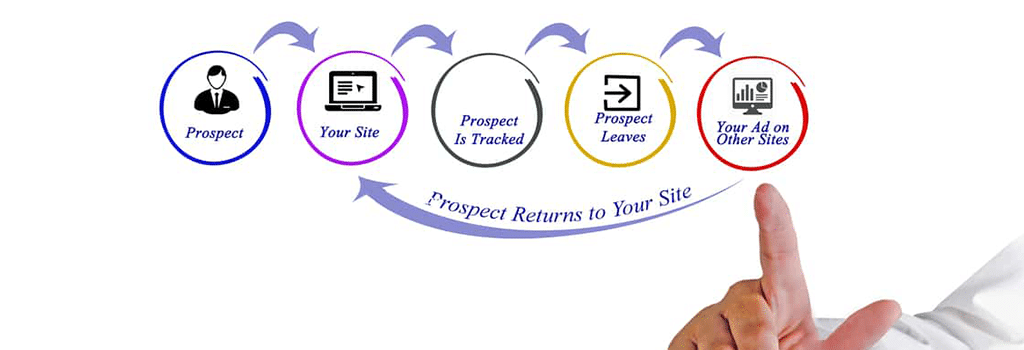What Is Remarketing (Retargeting)?
Remarketing refers to a digital marketing strategy that involves serving targeted ads to users who have previously interacted with a brand, such as visiting their website or app.
Most people use the words “remarketing” and “retargeting” interchangeably.
Here’s how remarketing via digital advertising usually works:
- Someone visits your website
- The remarketing code you have installed on your website places a “cookie” in that person’s browser
- You show ads to that person as they browse other websites and social media platforms
Definition and Explanation
Remarketing is a digital marketing strategy that involves serving targeted ads to users who have previously interacted with a brand, such as visiting their website or app.
The goal of remarketing is to keep the brand top of mind for potential customers, increasing the likelihood of conversion. Remarketing ads can appear on other websites, apps, and social media platforms where the target audience is likely to be.
By continuously engaging with users who have shown interest in your products or services, remarketing helps in nurturing leads and driving them towards making a purchase.
How Remarketing Works
Remarketing works by re-engaging users using advanced tracking technologies that don’t rely solely on cookies. Platforms like Google Ads, Facebook Ads, and other social media platforms leverage device identifiers, IP addresses, or user behavior to recognize individuals and deliver personalized ads.
This approach ensures privacy compliance while maintaining the efficacy of remarketing efforts. Brands can strategically nurture leads, increase conversions, and elevate personalization strategies without worrying about the demise of cookies.
By understanding user behavior and preferences, remarketing allows for highly relevant and timely ads that resonate with potential customers.
Benefits of Remarketing
Increase Conversions and Brand Awareness
Remarketing campaigns can lead to a 161% increase in click-through rates compared to regular display advertising. Users are more likely to engage with brands they recognize, thanks to the familiarity principle.
Remarketing reinforces brand awareness, builds trust, and guides users further down the conversion funnel. Tailored ads enhance relevancy and boost engagement rates. Advanced remarketing platforms allow brands to adjust ad frequency and messaging to prevent ad fatigue.
By consistently reminding users of your brand and offerings, remarketing helps in converting interested prospects into loyal customers.
Converting the Other 97%
On average, only 3% of people visiting an ecommerce website decide to make a purchase during their visit (websites that focus on lead generation tend to convert at a higher rate, but still regularly see a ~90% non-conversion rate from their visitors).
You can use remarketing to reach the other 90% – 97% of your past visitors who were interested enough in your product/service to reach your site, but who didn’t pull the trigger and take a valuable action during their visit.
Remarketing Campaigns on the Google Display Network
The Google Display Network is a conglomeration of 2+ million websites that show text, image, and video ads from Google. Over 90% of the people using the internet browse websites that are opted into the Google Display Network.
Example websites on the Google Display Network include:
You can serve ads on the Google Display Network through Google AdWords as part of your remarketing campaign.
Google Dynamic Remarketing
Google Dynamic Remarketing works best for ecommerce, travel, real estate, and other websites with lots of product/service listings, making it ideal for dynamic remarketing campaigns.
To use it, install specific remarketing code on your website pages that lets Google identify which pages people have visited. Then, if those individuals leave your website without taking the action you wanted them to, you can remind them of your brand/product/service via the various websites on the Google Display Network, using dynamically-generated ads that showcase the actual or related products/services they originally looked at on your site.
Example: Jane is looking for a gift for her husband, Bob. She looks at the power tools on your website and views a specific product page. She knows she still has time before she has to purchase the gift, so she moves on with her day and doesn’t make a purchase.
Later she reads an article on forbes.com, and on that site sees your ad for the exact drill she saw on your site previously. This ad reminds her about the drill and your company, and she clicks through the ad and buys the drill from you. Google Dynamic Remarketing success!
Google “Static” Remarketing
We call this form of remarketing “static” remarketing to differentiate it from dynamically-generated ads, but it can still be very customized. Instead of customizing code on your pages, you install a single remarketing code across your entire website. You can then create lists of people to target based upon the pages they visited on your website.
Example: Jane Googles “home inspection” and clicks your ad to view your home inspection landing page. She moves on to a couple of other competitor websites and makes a mental note to talk to her husband, Bob, about their options that night.
Later that afternoon she browses a baking site for a dinner recipe and sees your ad offering a 10% discount off a home inspection. Your “static” remarketing ad reminds her to discuss your service with Bob, and now she is extra motivated in response to your special offer.
Google Search Remarketing
You can also use Remarketing lists in your Search campaigns as a marketing tactic. There are two primary strategies:
- Bid based on whether the person seeing your Search ad has been to your website. People who have already engaged with your company online are usually more likely to buy from you than people who don’t know you, so typically you will want to increase your normal bid (on average by at least 20%) when you’re targeting people who have previously visited your site.
- Advertise on broader keywords than you usually target if the people triggering those broader keywords have been to your website. For example, if you only sell women’s shoes, it’s probably not profitable to target the keyword shoes. But, if someone has been to your website and is now searching for shoes, it may be reasonable to assume they are interested in women’s shoes. So it may be profitable to show your ad to that person when they search for shoes, even though typically you would not bid on such a broad keyword.
Facebook Remarketing
Most of the people visiting your website use Facebook, and they probably spend lots of time looking through their Facebook News Feed, making it an ideal platform to reach your target audiences. You can turn their personalized News Feed browsing into a reminder to come back and purchase your product or service.
Facebook Dynamic Product Ads
Facebook’s Dynamic Product Ads work similarly to Google Dynamic Remarketing. You use custom code on your website and a product feed uploaded to Facebook to dynamically show product ads to previous visitors based on the specific products those people have viewed on your website, as well as related products.
Facebook “Static” Remarketing
Facebook “static” remarketing is also similar to Google “static” remarketing. By placing a single piece of code called the Facebook pixel on your website, you can remarket to anyone who has visited your site, to people who have reached specific pages on your site, to people who have spent a specified amount of time viewing your website, etc.
Using Customer Emails to Target Audiences on Google and Facebook
Advanced advertisers go a step beyond just tracking people who have been to their websites by employing various remarketing tactics.
You can also use your list of customer email addresses to remarket to people on the Google Display Network and Facebook.
Facebook Custom Audiences
You can upload a list of your website visitors’ email addresses or phone numbers to Facebook and Facebook will match that information to Facebook users. You can use that list in multiple ways:
- Upsell new products or services to your customers
- Remind customers to purchase your product when you know they’re about to run out, or when the season/holiday is right
- Reach “lookalike” audiences of people who haven’t purchased from you, but who Facebook thinks are similar to your customers
Google AdWords Customer Match
Google’s Customer Match feature is similar to Facebook’s custom audiences, although not as flexible.
You can upload a list of customer email addresses to use for YouTube, Gmail, and Search targeting. Unfortunately, you can’t yet use Customer Match for targeting on the Google Display Network, which is a limitation we hope Google eventually removes.
You can use your email list to:
- Upsell products/services to your customers via YouTube ads, or show them video customer testimonials to keep them loyal to your subscription service
- Create streamlined versions of your best-performing email campaigns and serve your clients Gmail ads at the top of their Promotions tab in Gmail
- Tweak your bids in Search campaigns when you know that an existing customer is seeing your ad
Measuring Success in Remarketing
Key Performance Indicators (KPIs)
To measure success in remarketing, marketers should track key performance indicators (KPIs) such as:
- Lead conversion (CPL): The number of leads that are directly attributed to remarketing ads.
- Nurture touches: Engagement from existing contacts with remarketing display ad campaigns.
- View-through conversions: A conversion that occurs when a prospect views a remarketing display ad but doesn’t click and returns to the website or clicks to the landing page on their own.
- Page visits: The number of visitors that arrive at the remarketing landing page from the ad.
- Email opens: Reaching out to prospective customers through email is a powerful form of remarketing.
- Marketing qualified leads (MQL): Leads whom the marketing team has qualified as more likely to become customers in comparison to other leads.
By tracking these KPIs, marketers can optimize their remarketing campaigns for better performance and ROI, and make data-driven decisions to improve their overall marketing strategy. This ensures that remarketing efforts are not only effective but also efficient in driving conversions and enhancing brand awareness.
Measuring Success in Remarketing: Don’t Be Creepy
The #1 rule to remarketing is: Don’t be creepy.
People are getting more accustomed to seeing remarketing ads, but there can still be a certain level of “freak out” if someone feels like everything they do online is tracked and exploited.
You can prevent the potential creep factor and/or prevent your audience from being annoyed by:
- Being smart about how many days or weeks in a row you continue remarketing to the same person
- Limiting frequency caps so that you control how often in a day or week people see your ads
To sum it up, remarketing (or retargeting) is an effective way to maximize your digital ad dollars and manage your ad spend efficiently.
If you’re not already doing it, and doing it the right way, get in touch we can help!




